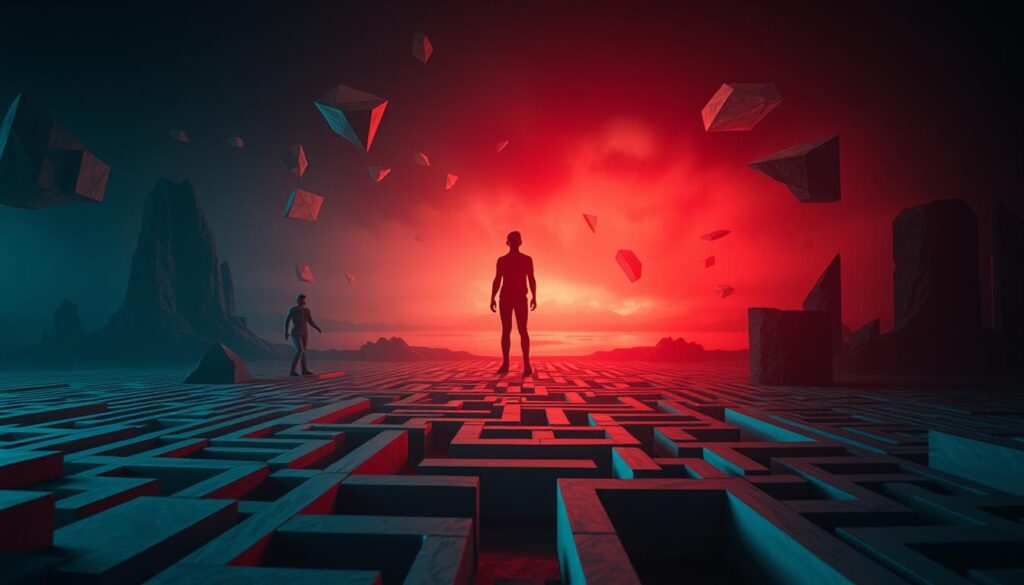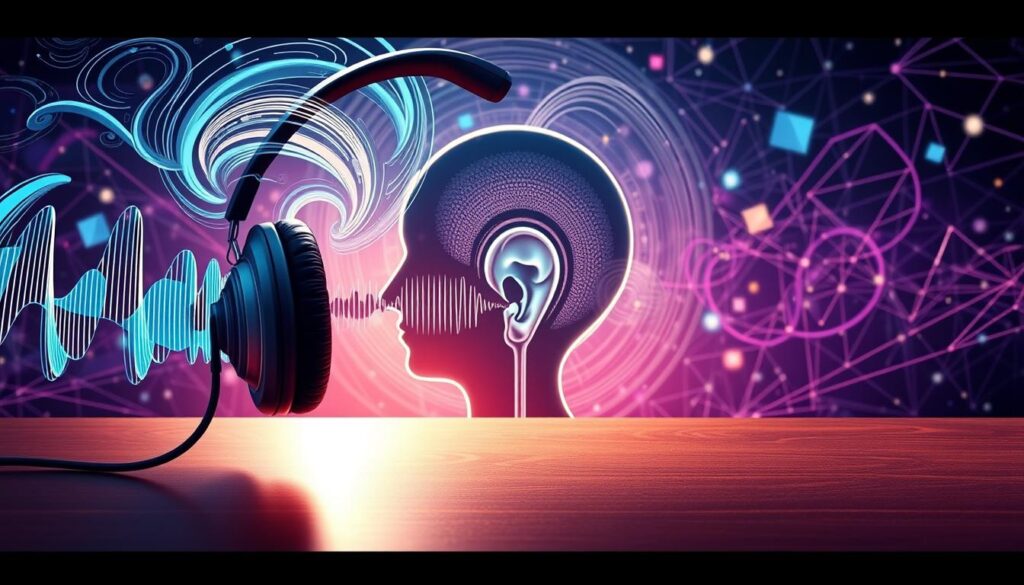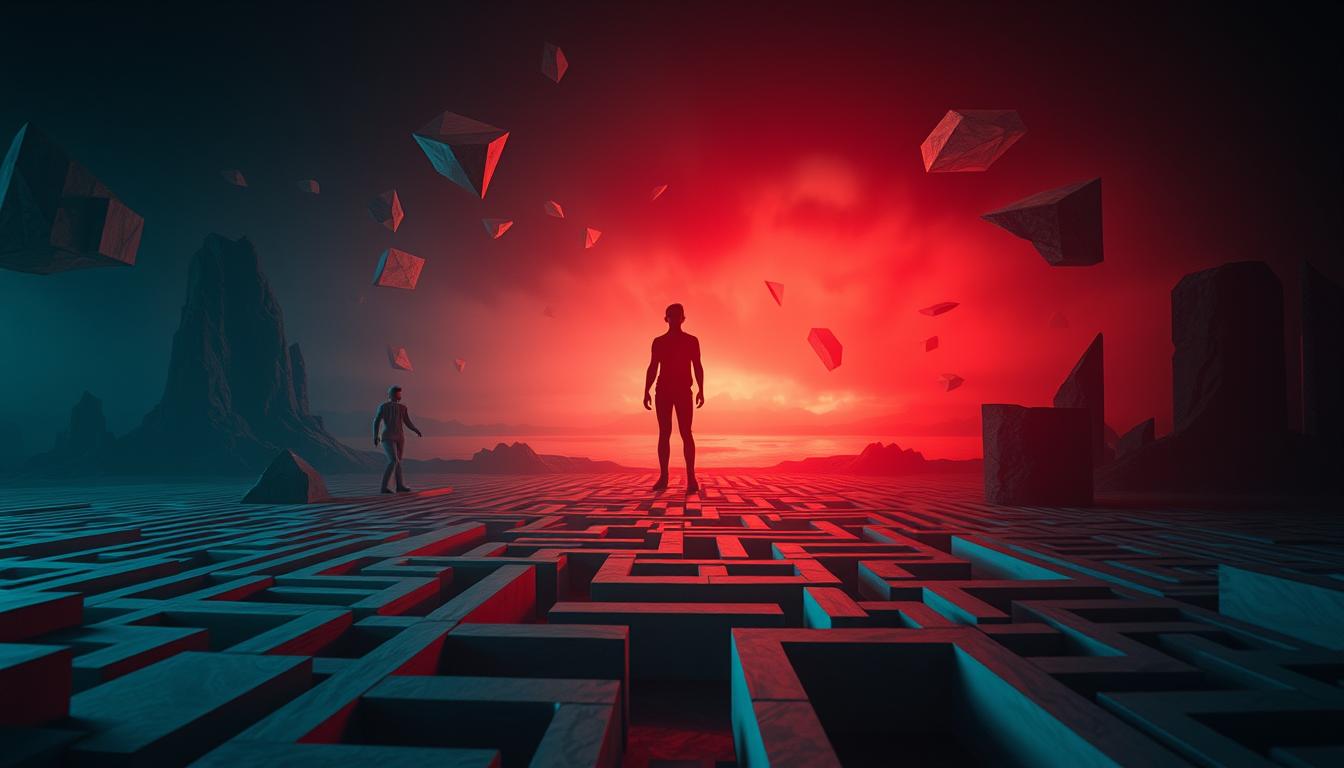Our brains do amazing things, but they can also be tricked. This happens because of how our brains process information. Tricks can change how we see the world, making it seem different than it really is.
Understanding how our brains work is key. By looking into brain tricks, we learn more about our minds. This knowledge helps us see the world more clearly.

Exploring how our brains see reality shows us many ways we can be misled. Optical illusions and biases are just a few examples. Knowing these tricks helps us appreciate how complex our brains are.
Key Takeaways
- Our brains can be tricked into perceiving reality in a way that is not entirely accurate
- Neural pathways and pattern recognition play a significant role in shaping our perception of reality
- Brain tricks and mind tricks can have a profound impact on our understanding of the world
- Perception is a complex concept that can be influenced by various factors
- Understanding how our brains can be fooled can help us better navigate the complexities of reality
- By examining the relationship between perception and reality, we can develop a greater appreciation for the complex nature of our brains
Understanding How Your Brain Processes Reality
Our brain’s ability to process reality is complex and fascinating. How we see the world is shaped by our past, emotions, and neural pathways. These pathways are key in understanding reality and can change based on what we see and hear.
The way we perceive things is linked to brain function. Our brains look for patterns and make connections. This can sometimes lead to seeing things that aren’t really there. It shows how important it is to know how our brains work and what affects our perception of reality.
Several factors can change how we see reality. These include:
- Past experiences and memories
- Emotions and emotional state
- Sensory information from the environment
- Neural pathways and brain function
By understanding these factors, we can see how complex perception is. This knowledge helps us appreciate the tricks our brains play on us. It shows how our perception of reality can be influenced.
In the next section, we will look at classic tests and experiments. They show how our brains can be tricked. They also show how different factors can change our perception of reality.
The Classic Color and Word Test
This test is a cool example of brain tricks that can trick our minds. It uses words and colors to show how our brains connect different things. It’s designed to test our perception and how easily our brains can be misled.
The test shows words in different color fonts, but with a twist. For instance, “red” might be in blue font, and “blue” in red font. This mix-up makes it hard for our brains to get it right.
Understanding this test helps us see how our brains work. It’s a fun way to learn about perception and how different things affect our thinking. It’s a great example of mind tricks that teach us about our brain’s processes.
In summary, the classic color and word test is a mind-bending example of how our brains can be tricked. By trying it out and learning about it, we can understand our brains better. This knowledge can help us make smarter choices and improve our thinking skills.
Your Brain’s Pattern Recognition System
Our brains are wired to recognize patterns. This is key in how we understand the world. It helps us make sense of all the information around us. This shapes our perception and our view of reality.
By recognizing patterns, our brains can fill in gaps and make predictions. This is crucial for survival and daily life.
The brain’s pattern recognition system is closely tied to brain function. It relies on quick information processing. When we face new situations, our brain looks for patterns and connections to past experiences.
This helps us respond and react. It’s vital for learning and memory. It lets us store new information and recall it when needed.
- Automatic processing: Our brains process patterns automatically, without conscious awareness.
- Learning and memory: Pattern recognition is essential for learning and memory consolidation.
- Influence on perception: Patterns can influence our perception of reality, sometimes leading to misperceptions or illusions.
Understanding our brain’s pattern recognition system is important. It helps us see the complexity of perception and reality. By recognizing the role of patterns, we can learn more about our brain and how it functions.
Test That Shows How Easily Your Brain Is Fooled: The Mirror Exercise
The mirror exercise is a simple yet fascinating mind trick that shows how easily our brains can be tricked. It uses a mirror and a few easy steps. This helps us understand how our brains work and how they can be influenced by perception and reality.
Our brains are wired to find patterns, which can lead to brain tricks that change how we see reality. The mirror exercise is a great example of this. It shows how our brains can be tricked into seeing things that aren’t really there. This exercise helps us see how our brains create our reality and how mind tricks can affect our thoughts and actions.
Here are some key points to consider when trying the mirror exercise:
- Stand in front of a mirror and observe your reflection.
- Notice how your brain processes the information it receives from the mirror.
- Consider how your perception of reality might be influenced by the mirror exercise.
By trying the mirror exercise and understanding how it works, we can learn more about our brains. This knowledge helps us navigate the world better and make smarter choices. The mirror exercise is just one way brain tricks and mind tricks can shape our perception of reality.
The Power of Contextual Illusions
Our brains are wired to see the world in a certain way. Contextual illusions shape how we see reality. The environment and social context we’re in greatly affect our understanding of the world. For example, who we hang out with can change how we see things.
A big part of contextual illusions is the environment. The table below shows how different places can change how we see things:
| Environment | Impact on Perception |
|---|---|
| Urban | Increased stress, altered sense of time |
| Natural | Reduced stress, improved mood |
| Social | Influenced by social norms, peer pressure |
Learning about contextual illusions helps us understand human perception and brain function better. By knowing how environment and social factors affect our view of reality, we can fight illusions. This way, we can see the world more clearly.
Environmental Factors in Perception
Things like lighting, temperature, and noise can change how we see reality. For instance, a dark room can make us more open to illusions. But a bright room helps us see things more clearly.
Social Context and Brain Processing
Social context also shapes our view of reality. The people we hang out with, the norms we follow, and our culture can all affect how we process information. Being mindful of these can help us see reality more accurately.
Audio Perception Tricks and Tests
Our brains can play tricks on us, especially with audio perception. The way we hear sound can change because of different factors. This leads to cool brain tricks and mind tricks. For example, the McGurk effect makes our brains mix what we see and hear to create a new sound.
The Shepard tone is another cool trick. It makes us think a sound is going up or down forever. These audio perception tricks show how our brains can see reality differently. Learning about these tricks helps us understand our brains better and how sound affects them.
Here are some key points to consider:
- Audio perception can be influenced by visual information
- Brain tricks and mind tricks can affect the way we process sound
- Understanding these tricks can provide insight into the workings of our brains

Memory Manipulation: The False Memory Test
Our brains can change memories, leading to misunderstandings and illusions. This shows how brain function shapes our perception of reality. The false memory test is a great example of how our minds can trick us into remembering things that didn’t happen.
Creating memories is a complex process. But studies show that memory manipulation can happen for many reasons. These include suggestions, emotions, and social pressures. This can make us remember things that are not true, but feel very real.
It’s important to understand how memories are made and changed. This helps us see the tricks our minds play on us. By knowing about memory manipulation, we can improve our thinking and decision-making.
Several things can lead to memory manipulation:
- Suggestions and social influences
- Emotional states and experiences
- Prior knowledge and expectations
Knowing these factors helps us understand how our brain function and perception of reality can be affected. We can then work to reduce the impact of memory manipulation.
Visual Processing Challenges
Our brains are amazing, but they can be tricked. This happens a lot with visual processing. Things like context, attention, and past experiences can affect how we see things. By learning about how our brains work, we can understand how brain tricks and mind tricks influence us.
It’s fascinating how our brains can make us see things that aren’t there. This can happen for many reasons. For example, the blind spot test shows how our brains can be tricked.
The Blind Spot Test
The blind spot test is a simple yet powerful trick. By looking at a specific point on a screen and closing one eye, we create a “blind spot.” This can make our brains see things that aren’t there. It’s a great example of how visual processing can be influenced by brain tricks and mind tricks.
Motion and Stability Illusions
Motion and stability illusions are another way our brains can be tricked. These illusions use simple visual stimuli, like moving dots or lines. They can make us see motion or stability where there is none. This shows how perception can be influenced by visual processing and how our brains can be tricked.

Understanding how our brains process visual information is key. It helps us appreciate the complex workings of our minds. Whether it’s the blind spot test or motion and stability illusions, exploring visual processing and perception is fascinating.
Time Perception Experiments
Our brains can play brain tricks on us, especially with time perception. Time perception is how our brains understand and measure time. Many experiments have shown how our brains can trick us into seeing time differently. Our emotions, focus, and memories can all affect how we see time.
Some cool mind tricks involve how we guess the length of events. For example, time can seem to slow down or speed up based on how engaged or emotional we are. Here are a few examples of time perception experiments:
- The stopwatch experiment: People are asked to guess how long a task takes while doing it. They often guess too long or too short.
- The waiting game: People are asked to wait for a bit, and how long it feels is measured. It shows that boredom or interest can change how we see time.
These experiments show how our brains can trick us into seeing time differently. By understanding these brain tricks
Conclusion: Understanding and Embracing Our Brain’s Limitations
Our perception of reality is much more complex than it seems. Our brains handle a huge amount of sensory info, making quick decisions and shaping our view of the world. This ability helps us live our daily lives smoothly but also makes us vulnerable to clever tricks.
Knowing our brain’s limits helps us see the world more critically. We can question our first thoughts, ask deeper questions, and look at things from different angles. This knowledge lets us make better choices, talk more clearly, and solve problems in new ways.
FAQ
What is the classic color and word test?
The classic color and word test is a simple trick that shows how our brains can be fooled. It uses words and colors to show how we process information. It also shows how we connect different things.
How does pattern recognition shape our understanding of the world?
Our brains are great at finding patterns. But sometimes, this can lead to mistakes and illusions. The section on “Your Brain’s Pattern Recognition System” talks about how patterns affect our perception.
It also talks about when pattern recognition fails and the surprises that can happen when we break patterns.
What is the mirror exercise that shows how easily our brains can be fooled?
The mirror exercise is a simple trick that shows how our brains work. It reveals how we connect different things. By understanding this, we can learn more about our brains and how they can be influenced.
How do contextual illusions influence our perception of reality?
The section on “The Power of Contextual Illusions” talks about how our environment and social context shape our view of the world. Our brains are influenced by the context we see things in. This can sometimes lead to mistakes and illusions.
What are some fascinating audio perception tricks and tests?
The section on “Audio Perception Tricks and Tests” introduces some cool tricks and tests with sound. These show how our brains process information and connect different senses. They also show how easily our brains can be tricked.
How can memory manipulation lead to false memories?
The section on “Memory Manipulation: The False Memory Test” talks about how memories are made and why we might remember things that didn’t happen. Our brains can change memories, which affects our understanding of reality.
What are some visual processing challenges that can fool our brains?
The section on “Visual Processing Challenges” introduces the blind spot test and motion and stability illusions. These show how our brains process visual information and can be tricked into seeing things differently than they are.
How can time perception experiments fool our brains?
The section on “Time Perception Experiments” explores how our brains process time and can be tricked into seeing time differently. These experiments give us insights into how our brains work and how they can be influenced.
